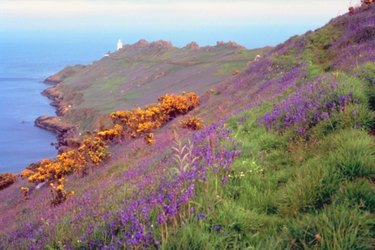
The 19th century Arts and Crafts movement in England and America saw a revival of interest in nature and plants. In England, the Horticulture Society (later a royal society) was formed in 1804. In 1829, Dr. Nathaniel Bagshaw Ward discovered, accidentally, that plants kept under glass created their own microclimate. Plants transpired water during the day, which condensed on the glass. The plants reabsorbed the water. Greenhouses sprang up, as did lawns with carpets of flowers.
Native Flowers
Video of the Day
The Arts and Crafts movement focused on getting back to nature culminated in William Robinson's "The Wild Garden," published in 1870. It advocated cottage gardens cultivating wildflowers and native plants, namely mixing trees, perennials and bulbs. Magazines were filled with articles focusing on the Country Life movement, revering rural culture and agricultural concerns. Henry Ward Beecher's 1859 book, "Plain and Pleasant Talk about Fruits, Flowers and Farming" cites lilac as a "favorite little tree" and the snowball and snowberry as favored plants during the time of its writing.
Video of the Day
Bougainvillea
The Bougainvillea is named after a shipmate of its discoverer, Philibert Commercon. B. Glabra and B. spectabilis were introduced to Europe in the early 19th century and were in high demand through the late 1800s. This plant thrives in a hanging container, which would have worked well in a 19th century gardenesque-style garden, a design displaying an eclectic variety of plants in a tiny space.
Cape Heath
In Britain, Australian and South Africa, plants were widely used in greenhouses. Cape heath was the first family of ornamental bushes to rise in popularity. By 1826, 285 cultivars of Cape heath existed, and varieties were cultivated throughout the century. The plant is generally adapted to hot, dry summers. The plant is a type of heather and produces flowers of varying size, shape and color from white to crimson round buds on the Easter heather to yellow teardrop blossoms on the Erica pageana.
Rose
The rose was as fascinating and popular in the 19th century as it is today. Focus was placed on a plant's natural, wild growth, with roses being depicted with plenty of foliage and full blossoms. Typical varieties were the damask rose, maiden's blush, Galica, D' amour and tomentose. The rose would be trained differently in a geometrically designed garden, which was in resurgence in the 19th century due to John Claudius Loudon's book, "Remarks on Laying out Public Gardens and Promenades." Roses were pruned neatly into symmetrical shapes.